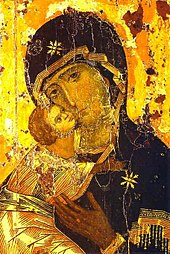Vladimir-Suzdal
[19] In the same year, he supposedly founded the fortified outpost of Vladimir (Volodimer) on the Klyazma, to control that river and defend against raids of the Volga Bulgars who had attacked in 1107.[citation needed] The foundations of Pereslavl, Kostroma, Dmitrov, Moscow, Yuriev-Polsky, Uglich, Tver, Dubna, and many others were assigned (either by chronicle or popular legend) to G, whose sobriquet ("the Long-Armed") alludes to his dexterity in manipulating the politics of far-away Kiev.[citation needed] Yuri's son Andrey Bogolyubsky significantly increased Vladimir's power at the expense of the nearby princely states, which he treated with contempt.[citation needed] Unwilling to share power with his brothers and cousins, he drove them out and seized all their lands by 1162, thus uniting his father's patrimony in Vladimir-Suzdal under his sole rule (samovlastets).Gleb's death in 1171 led to yet another succession crisis that saw the Suzdalians kicked out of Kiev; Andrey formed another coalition in an attempt to retake the capital, but was utterly defeated in the Siege of Vyshgorod (1173).[23] During the 1174–1177 Suzdalian war of succession, Andrey's brother Vsevolod III secured the throne of Vladimir, although the Yurievichi lost control of the Novgorod Republic for a decade.[25] Instead, Vsevolod's chief focus was on subjugating the southern Ryazan Principality, which appeared to stir discord in the princely family, and the mighty Turkic state of Volga Bulgaria, which bordered Vladimir-Suzdal to the east.His eldest son Konstantin gained the support of powerful Rostovan boyars and Mstislav the Bold of Kiev and expelled the lawful heir, his brother George, from Vladimir to Rostov.As many factions strove for power, the principality rapidly disintegrated into eleven tiny states: Moscow, Tver, Pereslavl, Rostov, Yaroslavl, Uglich, Belozersk, Kostroma, Nizhny Novgorod, Starodub-upon-Klyazma, and Yuriev-Polsky.[citation needed] By the end of the century, only three cities — Moscow, Tver, and Nizhny Novgorod — still contended for the title of Grand Prince of Vladimir.As part of the Christian world, Rus' principalities gained a wide range of opportunities for developing their political and cultural ties not only with Byzantium but with the European countries, as well.Whitestone cathedrals, decorated with sculpture, appeared in the principality of Vladimir-Suzdal due to Andrey Bogolyubsky's invitation of architects from "all over the world".[citation needed] In the early Middle Ages, Rus' principalities were similar to other European countries culturally and in historical development.Also, by the middle of the twelfth century, the dominating influence of the Kievan Rus’ (some historians do not consider it possible to even call it a state in the modern sense of the word) began to wane.[citation needed] The invasion of Batu Khan and subsequent domination of Rus' lands by the Golden Horde was also a turning point in the history of Russian culture and statehood.[29] Feofan's style is distinguished by its monochromatic palette and uncommon expressiveness of laconic blots and lines, which send a message of a complex symbolic implication, close to the then widely-spread doctrine of hesychasm, from Byzantium.
Rostov-Suzdal in
c.
1100

Inherited by
Konstantin of Rostov
Inherited by
Yaroslav of Suzdal


Alexander NevskySuzdalVladimirRussianRussian OrthodoxyMonarchyGrand PrinceYuri DolgorukyDmitry DonskoyKievan Rus'Grand Principality of MoscowRussiaHistory of RussiaEarly SlavsRus' peopleRus' KhaganateArthaniaGarðaríkiAncient Rus'Baptism of Rus'Russkaya PravdaNovgorod LandPrincipality of PolotskPrincipality of ChernigovRostov-SuzdalCouncil of LiubechCouncil of UvetichiMongol conquestBattle of KulikovoNovgorod RepublicPrincipality of MoscowTsarist RussiaGreat Stand on the Ugra RiverTime ofTroublesZemsky SoborTreaty of NystadPetrovian reforms1812 Patriotic WarDecembrist RevoltEmancipation reformRusso-Japanese War1905 RevolutionOctober ManifestoSecond Patriotic WarTsardom of RussiaRussian EmpireRussian AmericaGrand Duchy of FinlandCongress PolandRussian ManchuriaUryankhay KraiRussian RevolutionFebruary RevolutionProvisional GovernmentDvoyevlastiyeJuly DaysKornilov affairDirectorateConstituent AssemblyelectionBolshevik CoupCivil WarWhite GuardRed ArmySoviet-Polish WarPriamuryeGovt.War CommunismEmigrantsRussian RepublicGeneral Secretariat of UkraineUkrainian SSRByelorussian SSRTranscaucasian SFSRRussian StateProvisional Priamurye Govt.full list...Soviet EraCultural revolutionKorenizationStalinismCollectivizationIndustrializationGreat PurgeGreat Patriotic WarCold WarWarsaw PactComeconCrimeatransferEra of StagnationAfghan WarPerestroikaChernobyl disasterKarabakhWarParade of sovereigntiesWar of LawsSoviet UnionRussian SFSRKarelo-Finnish SSRTannu TuvaModern RussiaAugust CoupBelavezha AccordsAlma-AtaProtocolUSSR dissolutionNearabroadConstitutional crisisPrivatizationOligarchyPutinismFive-Days WarPresidential termsamendmentsEurasian Economic UnionAnnexation of CrimeaWar in Donbas2020 amendmentsInvasion of UkrainePreludeMass emigrationDebt defaultSanctionsMobilization2022 annexationRussian FederationRepublic of TatarstanChechen RepublicRepublic of Crimea